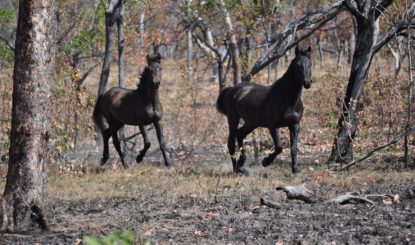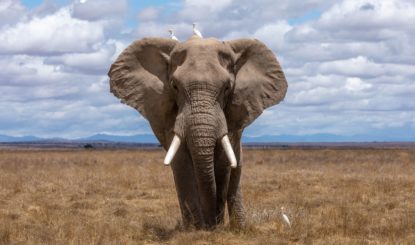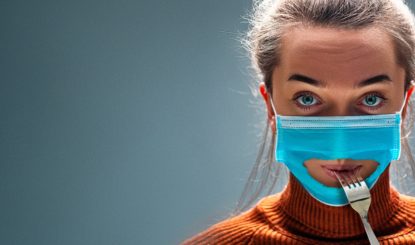Emaciated Stallion Finds Safe Home in the Wild Horse Reserve
Residents of Pine Creek informed us that an emaciated Brumby stallion was wandering around the village. We decided to take him into our Wild Horse Sanctuary Bonrook.
In late May of this year, we were informed by residents in Pine Creek, Northern Territory, Australia, that a bony, old Brumby stallion was wandering around the village. He grazed in parks, drank from bird baths, and searched for food in front yards. The emaciated, weak horse was exposed to the risks of accidents, so we decided to take him into our Wild Horse Sanctuary Bonrook.
One night, Jim, a friend of Bonrook Station Manager Sam Forwood, managed to lure the stallion from his front yard into the neighbouring Pine Creek Fire Station garden. The half-acre grassy area, well-fenced with shade and water, served well as a temporary solution.
Loading
The next morning, Sam and I arrived on the scene to get a closer look at the stallion. What a heart-breaking sight! The poor animal was completely emaciated. We called the vet, who could only examine him from a distance, as he could not be approached more than five meters. Because of his severely emaciated body and his probably old age, she had little hope for him and suggested euthanizing him. However, that was absolutely out of the question for me! I intervened vigorously and explained to her our work and vision at FFW. For me, it was clear: this horse wants to live, and we will bring it to safety on Bonrook!
Sam built two interconnected enclosures from mobile panels. We stretched a rope, which we gently guided behind the horse. This way, we were able to calmly lead him from the first enclosure into the second.
But now, how were we going to get him up the ramp and into the trailer? Entering a confined space is extremely unnatural for a horse, let alone a wild Brumby! This animal, however, did not exhibit much wild behaviour and seemed rather low on energy despite the stressful situation.
He was fearful and nervous, refusing to step into the trailer, kicking out, snorting with anxiety, and not moving forward. The situation demanded time, patience, and calm perseverance. Guiding him gently with the rope, Sam and two more helpers ultimately managed – almost miraculously – to lead the horse safely into the trailer and close the gate.
Arrival at Bonrook
The old stallion managed the approximately 30-minute journey to Bonrook quite well. When we opened the gate of the trailer, he gracefully trotted down the ramp onto the pasture, as if he was coming home. It was a wonderful experience to see him safe! He headed straight to the station horses, who were eagerly waiting on the other side of the fence, neighing in anticipation. Since the old riding horses are all geldings and he is a stallion, he made it clear that he is the alpha here. To avoid potential conflicts between the station horses and the stallion, we will keep him separated from the other horses on the pastures for the time being.
Road to Recovery
Our top priority was to get this stallion back to health and fitness. We dewormed him and fed him twice daily with special food for older horses. He always ate all of his food completely and showed more and more interest in his surroundings, becoming more attentive. Now, three months later, he has gained weight, his coat shines, and he has more life energy. We continue to feed him twice a day and will keep monitoring his recovery to decide if we can hopefully release him back into the wild with the other brumbies. That would be the ideal outcome! If, however, he continues to rely on special feed, we will keep him on the pastures next to the station horses and continue to care for him.
I had the honour of giving him a name: I named him Dandy. Dandy was my favourite horse at my first riding school in Switzerland when I was eight years old. He was a beautiful, sweet-natured, black-and-white Pinto. I loved Dandy so much and always knew that one day I would name a horse Dandy.
New Water Source on Bonrook Ensures Survival During Dry Season
During the dry season, there is recurring severe water scarcity in the south-eastern part of Bonrook. Rainfall becomes so sparse that the few existing waterholes quickly dry up. According to records, the last waterhole was drilled on Bonrook in 1973 – 50 years ago!
Thanks to a generous benefactor, FFW was able to commission Bynoe Drilling to drill for water in July 2023. Bonrook’s land is located in the granite belt north of the town of Katherine, where no known underground aquifers exist, making water extraction largely a matter of luck. Based on Bonrook Station Manager Sam Forwood’s knowledge of the rock formations and tree cover, he identified the suitable location for drilling, approximately 21 kilometres southeast of the homestead.
Remarkably, Bynoe Drilling’s first attempt was a success: We struck water at a depth of just six meters! The drilling was completed at a total depth of 43 meters. Our new water source has a flow rate of one litre per second, which is good for this region. Sam will equip it with a small solar pump, a water tank, and a trough for the animals. Since the waterhole is surrounded by Coolibah eucalyptus trees, Sam has named it “Coolibah Bore”.
More information:
- Our project page “Wild Horse Sanctuary in Australia”
- This article was first published in the Journal Franz Weber 145. You can find the PDF version of all previous magazines here.
- You have not yet subscribed to our quarterly magazine, the Journal Franz Weber? Order the latest issue for free here (in German and French only).


